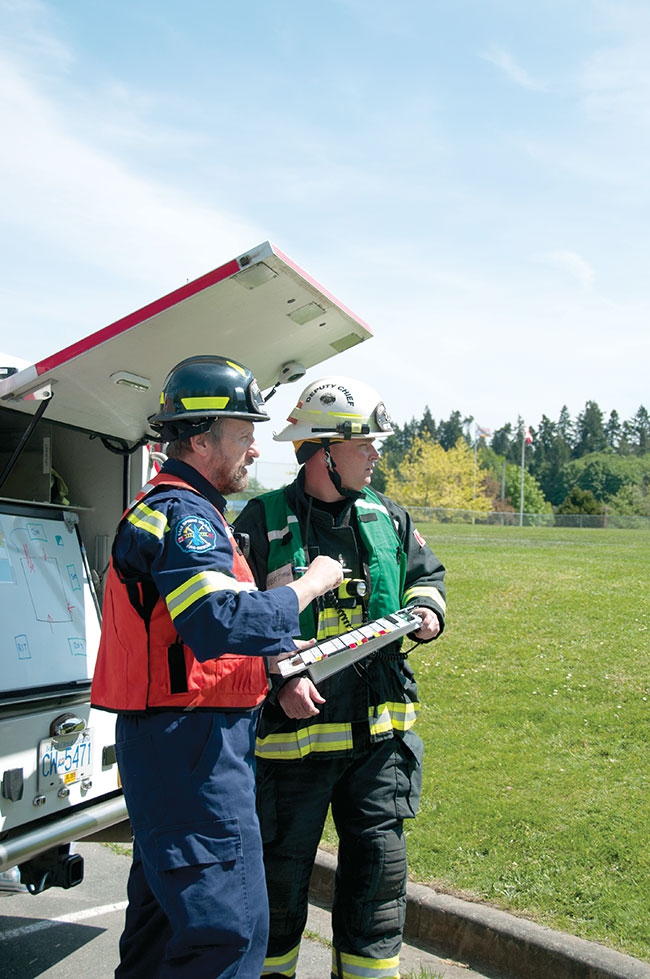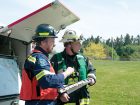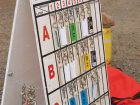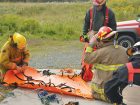
Features
Hot topics
Inside the hall
Editors’ pick 2015: The right FIT
June 1, 2015 - Salt Spring Island Fire Rescue (SSIFR) in British Columbia has been operating a field incident technician program since 2002. Today the department’s six field incident technicians – who are referred to as FITs – are a vital part of the organization.
May 22, 2015
By Arjuna George
 Salt Spring Island Fire Rescue’s FIT program diversifies its recruitment pool by welcoming non-firefighting members to the team. Salt Spring Island Fire Rescue in British Columbia employs field incident technicians – or FITs – to serve as command aides on the fire ground. By Arjuna George
Salt Spring Island Fire Rescue’s FIT program diversifies its recruitment pool by welcoming non-firefighting members to the team. Salt Spring Island Fire Rescue in British Columbia employs field incident technicians – or FITs – to serve as command aides on the fire ground. By Arjuna GeorgeSSIFR developed its paid-on-call FIT position based on a United States model in which senior officers or chiefs act as a command aides during incidents. SSIFR adapted the FIT position to suit people who are not interested in or capable of interior fire operations but are able to conduct cold-zone activities. Our FIT model can be used by any volunteer, paid-on-call or combination fire stations. The FIT role allows non fire-service members to be a part of the organization while freeing up firefighters to do that for which they are trained.
“The FIT program,” said Salt Spring Island Fire Chief Tom Bremner, “and the resource support that comes from it, allows firefighters to do their primary function – fire fighting.”
The Fit History
SSIFR’s FIT program was formed through a partnership with the local amateur-radio club. The members of the club are all experts in radio communication and documentation, and most have backgrounds that involved working under stress.
The FIT program’s origins can be traced to Steve Leichter, an amateur radio club member who is now one of SSIFR’s senior field incident technicians.
“I happened to go into the main fire hall during a call,” Leichter said, “and noticed that a firefighter was sitting at the desk operating the radio.
“This experience prompted a discussion with other members of the club and the question became clear. Why would a trained and experienced firefighter be behind a radio in the hall when he or she could be doing what they were trained to do?”
Discussions followed between Leichter and the fire chief and a new group of SSIFR radio operators was formed.
At that point, radio traffic was not monitored or recorded as it is now. The crucial role of documenting benchmarks is vital to our operations. The radio club members who joined the department made a huge impact on documentation and allowed members to focus their skills on fire response.
In the early days of the radio operators, the new members were considered to be part of an experiment, and there was no vision for how their position would evolve. Within two weeks of the radio operators joining the team, the department responded to the largest and most dangerous fire in the island’s recent history. It was a hot, dry and windy summer evening and a fire broke out in a large, multi million-dollar resort complex that was under construction. All the factors were there to generate the perfect storm. It was also the radio operators’ first page, and they jumped into action.
“In that incident,” Leichter recalled, “the radio operators went far beyond communications. They operated the radios in the fire hall, kept a full written log of the incident, handled incoming telephone calls, dealt with convergent volunteers, and arranged the logistics of bringing in firefighters from other islands.”
“For the first call,” Leichter said, “it was an extreme test.”
Fit Roles and Duties
FIT members are now responsible for fire-ground communication and an assortment of command-aide tasks. FITs have also become the primary accountability managers. The department’s operational guidelines state that the first FIT on scene will connect with the incident commander and establish, or take over member accountability. Having a dedicated member responsible for accountability alone has massively improved firefighter safety and command and control.
Incident commanders have one of the most stressful and challenging roles in today’s emergency services. Having FITs available allows incident commanders to delegate some of the tasks and focus on managing a safe fire ground.
In the first few years of development, the primary roles of the FITs were accountability, scribing and assistance with radio communication. The position has since evolved to include staging management, rehab management, and a few cold-zone activities. Our FITs assist the incident commander by managing phone calls, radio communication, pre-plans, hazmat identification, and documentation, all by using handheld dry-erase boards, waterproof paper, whiteboards and iPads. We have also developed specialized FIT checklists.
FITs do not make tactical decisions; they are simply a resource to provide information and assist the incident commander. FIT members are a second set of eyes and ears. Firefighter safety is the bottom line and FITs provide that added layer of safety on the fire ground.
Fit Training
SSIFR asks that its FITs maintain a minimum of 70 hours of training per year for active duty – less then what is asked of the interior firefighters. The training standard was carefully selected for a few reasons. For one, the manageable time commitment keeps the program attractive to members of our community who can not attend hundreds of hours of training.
Secondly, FITs require fewer hours of training because there are fewer skills required of them. The FIT training is very specific and focuses on only a few disciplines.
FITs train occasionally by themselves to concentrate on command-aide skills and accountability, but the majority of the training occurs alongside the firefighters and officers. Each FIT is assigned to a platoon for training. Having the FITs train with the firefighters encourages bonding and inclusion, and allows each member to see first-hand the value the other position brings to the team.
Incorporating Fits
As with all new things, change is a challenge. Incorporating a FIT program into a department must be done in such a way that the new FIT members feel welcomed, and the firefighters understand the new role. Becoming a FIT is not a steppingstone to becoming a firefighter; the roles are different and specific. If the lines are blurred the roles become confusing to the whole team. In the early FIT days the department was concerned about the perception that the new role was a back-door path to becoming a firefighter. However, with proper communication and roll out of the program, each member quickly became aware of the new role and how it is needed to stabilize incidents.
Since the days of the radio operators up to today’s well-defined FITs, SSIFR has not needed to actively recruit new members for the FIT positions. Most applications come to us via word of mouth, and most are from the local amateur-radio club’s membership. The department’s current FITs have a variety of professional backgrounds, including police and air-traffic control, that make them a perfect fit to work in high-stress emergency situations.
FITs are required to obtain an amateur-radio licence, if they don’t already possess it, within the first year, which allows for FIT-to-FIT back channel radio communication as well as a direct communications link to the EOC. An application process is in place and candidates are asked to provide a driver’s abstract and police records check prior to training.
Depending on the development of the FITs, most receive a pager at six months and begin responding to calls soon thereafter. FITs respond just as our firefighters do; if the pager goes off and they are available, they respond to the station or the scene. FITs respond to all fires, multi-car crashes, major hazmat calls, and any complex technical-rescue incident. The duty officers and chiefs are also able to specifically page out the FITs for other incidents if they deem it necessary.
The department cannot guarantee a FIT will respond, so it also has a roster to ensure the best coverage possible. Since a FIT is not guaranteed to attend an incident, it is also important to have the firefighters up to speed on basic accountability and command-aide tasks.
FITs are issued PPE that is suitable for cold-zone activities – coveralls, a rescue helmet, gloves, headlamp, boots and a cold-weather jacket. The clothing provides protection as well as visible identification at a much cheaper price than structural protective wear. There are also vests in the command totes to identify positions such as accountability and staging.
Expansion of the FIT program will include social-media monitoring and management in the field.
As a senior FIT, Leichter has several pointers for departments interested in starting their own FIT program:
- Take a good look at your operations. What jobs really need a trained firefighter to accomplish and what tasks can non-firefighters do just as well or better?
- Talk to your local emergency operations centre manager. Chances are there are already amateur-radio operators providing emergency communications services in your community. The EOC may be able to put you in contact with your local radio club or with experienced operators.
- Take it slow. Once you find a group of interested people, do a realistic evaluation. Would that person be able to take on certain duties and perform well in the stress of a fire ground? If yes, start off the program with just one or two.
- Provide training. Amateur-radio operators are likely already skilled in communications but will need training in fire-service procedures, safety and incident command. Reinforce the idea that they are not firefighters so they will not be involved with hot-zone activities, but are still essential members of the team.
- Integrate your new FITs into regular department activities, drills and team building.
- Keep an open mind. You will be surprised how many intelligent, skilled and experienced people are in your community. Not all people can or want to be front-line firefighters but they still have a lot to contribute if given the opportunity. Once the program is established, do not limit your FIT search to amateur-radio operators. Our current membership includes a former RCMP member, former air-traffic controller and former commercial radio-station owner.
Incorporating a version of a FIT program into a fire department deepens the recruitment pool and diversifies membership. Recruitment is challenging nowadays, so whatever creative fixes a department uses are worth the extra work. What FITs can contribute to a department is limited only by its members’ imaginations.
A Perfect Fit
What FITs can do for your department
■ Scribing
■ Accountability
■ Staging
■ Communication
■ Manage mayday calls
■ Social media monitoring
The benefits of FITs
■ Strengthen personnel numbers
■ Improve recruitment and retention
■ Make fire grounds safer and more efficient
■ An extra set of eyes and ears focused on firefighter safety
Steps to starting a fit program
■ Review operational need for FITs
■ Approach local EOC for contacts
■ Start slow with only one or two FITs
■ Provide training on fire-service SOPs
■ Integrate FIT members into regular department activities
For more information and a copy of our job description, checklists and operational guidelines, please get in touch.
Arjuna George is the deputy fire chief of operations on Salt Spring Island, B.C., and has served on the department since 1997.
ageorge@saltspringfire.com
@AJGeorgefire
Print this page


